18-2 Interstellar gas and dust pervade the galaxy
Different types of nebulae emit, absorb, or reflect light
Where do stars come from? As we saw in Section 8-4, our Sun condensed from a solar nebula, a collection of gas and dust in interstellar space. Observations suggest that other stars originate in a similar way (see Figure 8-8). To understand the formation of stars, we must first understand the nature of the interstellar matter from which the stars form.
Nebulae and the Interstellar Medium
At first glance, the space between the stars seems to be empty. On closer inspection, we find that it is filled with a thin gas laced with microscopic dust particles. This combination of gas and dust is called the interstellar medium. Evidence we will discuss for this medium includes interstellar clouds of various types, curious lines in the spectra of binary star systems, and an apparent dimming and reddening of distant stars.
You can see evidence for the interstellar medium with the naked eye. Look carefully at the constellation Orion (Figure 18-1a), visible on winter nights in the northern hemisphere and summer nights in the southern hemisphere. While most of the stars in the constellation appear as sharply defined points of light, the middle “star” in Orion’s sword has a fuzzy appearance. This fuzziness becomes more obvious with binoculars or a telescope. As Figure 18-1b shows, this “star” is actually not a star at all, but the Orion Nebula—a cloud in interstellar space. Any interstellar cloud is called a nebula (plural nebulae) or nebulosity.
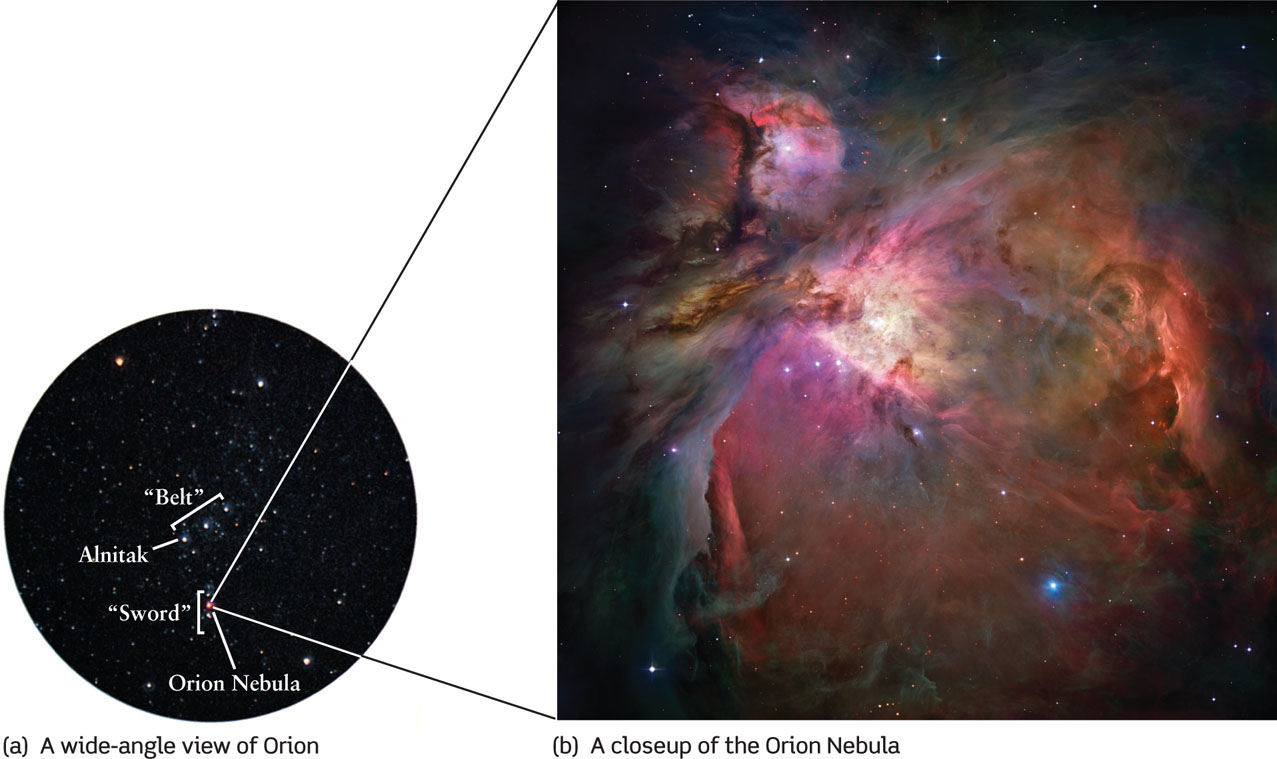
The Orion Nebul (a) The middle “star” of the three that make up Orion’s sword is actually an interstellar cloud called the Orion Nebula. (b) The nebula is about 450 pc (1500 ly) from Earth and contains about 300 solar masses of material. Most of the ultraviolet light that makes the nebula glow comes from just five hot massive stars.
Emission Nebulae: Clouds of Excited Gas
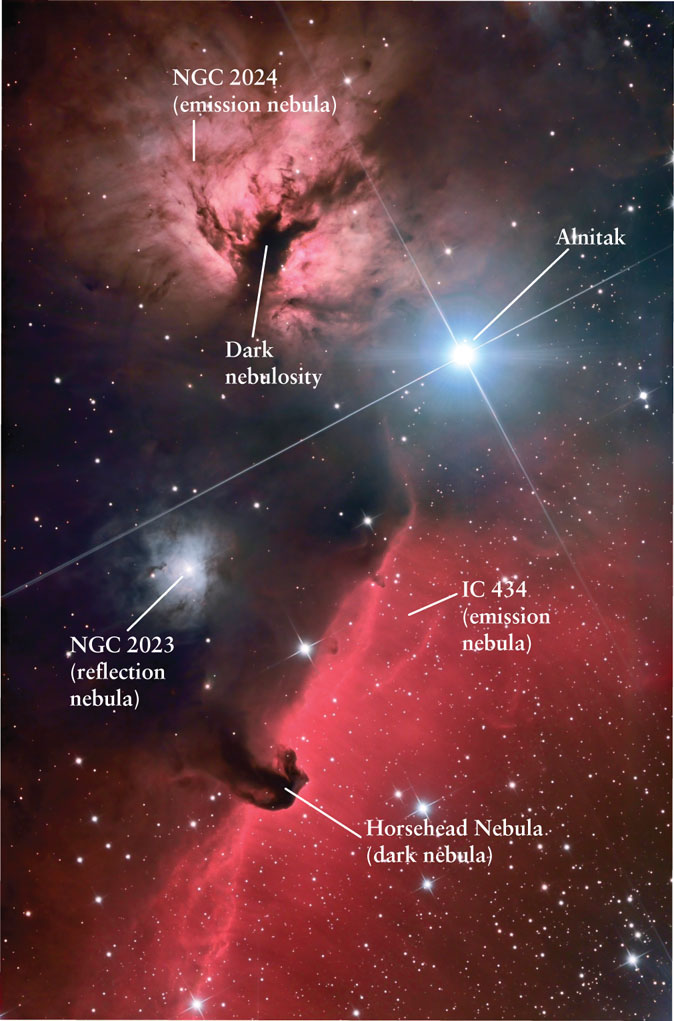
Emission, Reflection, and Dark Nebulae in Orion A variety of different nebulae appear in the sky around Alnitak, the easternmost star in Orion’s belt (see Figure 18-1a). All the nebulae lie approximately 500 pc (1600 ly) from Earth. They are actually nowhere near Alnitak, which is only 250 pc (820 ly) distant. This photograph shows an area of the sky about 1.5° across.
The Orion Nebula emits its own light, with the characteristic emission line spectrum of a hot, thin gas. For this reason it is called an emission nebula. Many emission nebulae can be seen with a small telescope. Figure 18-2 shows some of these nebulae in a different part of the constellation Orion. Emission nebulae are direct evidence of gas atoms in the interstellar medium.
507
Typical emission nebulae have masses that range from about 100 to about 10,000 solar masses. Because this mass is spread over a huge volume that is light-years across, the density is quite low by Earth standards, only a few thousand hydrogen atoms per cubic centimeter. (By comparison, the air you are breathing contains more than 1019 atoms per cm3.)
Emission nebulae are found near hot, luminous stars of spectral types O and B. Such stars emit copious amounts of ultraviolet radiation. When atoms in the nearby interstellar gas absorb these energetic ultraviolet photons, the atoms become ionized. Indeed, emission nebulae are composed primarily of ionized hydrogen atoms, that is, free protons (hydrogen nuclei) and electrons. Astronomers use the notation H I for neutral, un-ionized hydrogen atoms and H II for ionized hydrogen atoms, which is why emission nebulae are also called H II regions.
H II regions emit red visible light when some of the free protons and electrons get back together to form hydrogen atoms, a process called recombination (Figure 18-3). When an atom forms by recombination, the electron is typically captured into a high-energy orbit. As the electron cascades downward through the atom’s energy levels toward the ground state, the atom emits photons with lower energies and longer wavelengths than the photons that originally caused the ionization. Particularly important is the transition from n = 3 to n = 2. It produces Hα photons with a wavelength of 656 nm, in the red portion of the visible spectrum (see Section 5-8, especially Figure 5-23b). These photons give H II regions their distinctive reddish color.
For each high-energy, ultraviolet photon absorbed by a hydrogen atom to ionize it, several photons of lower energy are emitted when a proton and electron recombine. As Box 18-1 describes, a similar effect takes place in a fluorescent lightbulb. In this sense, H II regions are immense fluorescent light fixtures!
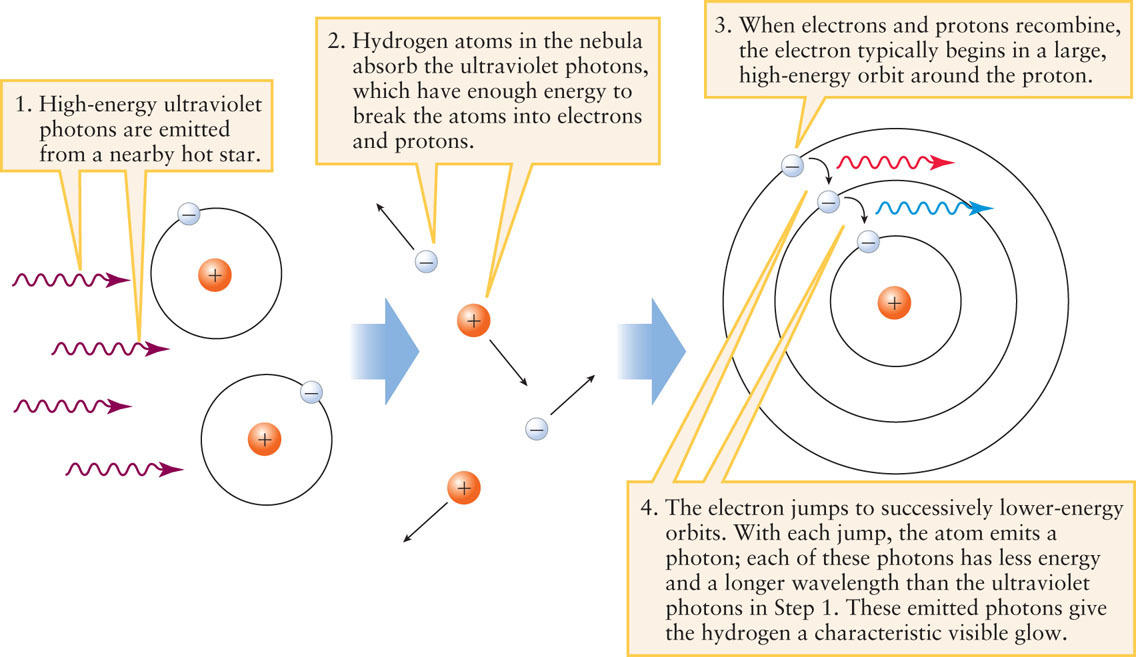
508
ASTRONOMY DOWN TO EARTH
Fluorescent Lights
The light that comes from glowing interstellar clouds is, quite literally, otherworldly. but the same principles that explain how such clouds emit light are also at the heart of light phenomena that we see here on earth.
A fluorescent lamp produces light in a manner not too different from an emission nebula (H II region). In both cases, the physical effect is called fluorescence: High-energy ultraviolet photons are absorbed, and the absorbed energy is reradiated as lower-energy photons of visible light.
Within the glass tube of a fluorescent lamp is a small amount of the element mercury. When you turn on the lamp, an electric current passes through the tube, vaporizing the mercury and exciting its atoms. This excited mercury vapor radiates light with an emission-line spectrum, including lines in the ultraviolet. The white fluorescent coating on the inside of the glass tube absorbs these ultraviolet photons, exciting electrons in the coating’s molecules to high energy levels.
The electrons in the molecules then cascade down through a number of lower levels before reaching the ground state. During this cascade, visible-light photons of many different wavelengths are emitted, giving an essentially continuous spectrum and a very white light. (By comparison, the hydrogen atoms in an H II region emit at only certain discrete wavelengths, because the spectrum of hydrogen is much simpler than that of the fluorescent coating’s molecules. Another difference is that the molecules in the fluorescent tube never become ionized.)
Many common materials display fluorescence. Among them are teeth, fingernails, and certain minerals. When illuminated with ultraviolet light, these materials glow with a blue or green color. (Most natural history museums and science museums have an exhibit showing fluorescent minerals.) Laundry detergent also contains fluorescent material. After washing, your laundry absorbs ultraviolet light from the Sun and glows faintly, making it appear “whiter than white.”
509
Further evidence of interstellar gas comes from the spectra of binary star systems. As the two stars that make up a binary system orbit their common center of mass, their spectral lines shift back and forth (see Figure 17-23). But certain calcium and sodium lines are found to remain at fixed wavelengths and these lines have captured the curiosity of observers. These stationary absorption lines are therefore not associated with the binary star. Instead, they are caused by interstellar gas between us and the binary system.
CONCEPT CHECK 18-1
Would it be correct to describe a reddish H II region as “red hot,” the way filaments in an electric toaster glow red?
Dark Nebulae and Reflection Nebulae: Abodes of Dust
In addition to the presence of gas atoms in red H II regions, Figure 18-2 also shows two kinds of evidence for larger bits of matter, called dust grains, in the interstellar medium. These dust grains make their appearance in dark nebulae and reflection nebulae.
A dark nebula is so opaque that it blocks any visible light coming from stars that lie behind it. One such dark nebula, called the Horsehead Nebula for its shape, protrudes in front of one of the H II regions in Figure 18-2. Figure 18-4 shows another dark nebula, called Barnard 86. These nebulae have a relatively dense concentration of microscopic dust grains, which scatter and absorb light much more efficiently than single atoms. Typical dark nebulae have temperatures between 10 to 100 K, which is low enough for hydrogen atoms to form molecules. Such nebulae contain from 104 to 109 particles (atoms, molecules, and dust grains) per cubic centimeter. Although tenuous by Earth standards, dark nebulae are large enough—typically many light-years deep—that they block the passage of light. In the same way, a sufficient depth of haze or smoke in our atmosphere can make it impossible to see distant mountains.
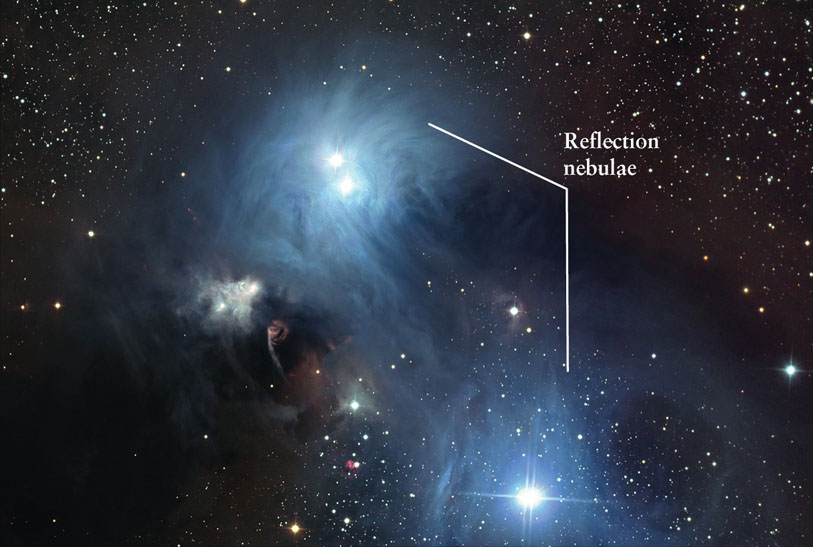
Reflection Nebulae Wispy reflection nebulae called NGC 6726-27-29 surround several stars in the constellation Corona Australis (the Southern Crown). Unlike emission nebulae, reflection nebulae do not emit their own light, but scatter and reflect light from the stars that they surround. This scattered starlight is quite blue in color. The region shown here is about 23 arcminutes across.
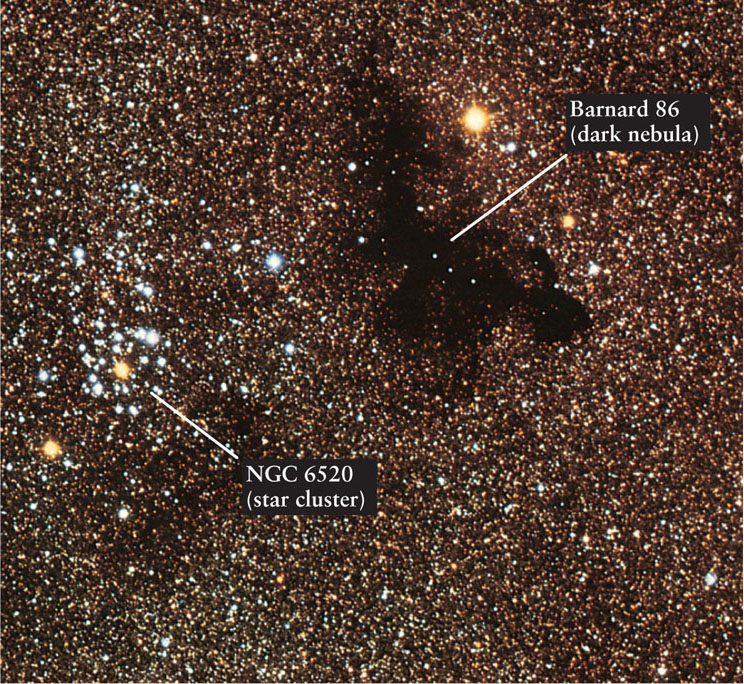
A Dark Nebula When first discovered in the late 1700s, dark nebulae were thought to be “holes in the heavens” where very few stars are present. In fact, they are opaque regions that block out light from the stars beyond them. The few stars that appear to be within Barnard 86 lie between us and the nebula. Barnard 86 is in the constellation Sagittarius and has an angular diameter of 4 arcminutes, about 1/7 the angular diameter of the full moon.
The other evidence for dust in Figure 18-2 is the bluish haze, labeled NGC 2023, surrounding the star immediately above and to the left of the Horsehead Nebula. Figure 18-5 shows a similar haze around a different set of stars. A haze of this kind, called a reflection nebula, is caused by fine grains of dust in a lower concentration than that found in dark nebulae. The light we see coming from the nebula is starlight that has been scattered and reflected by these dust grains. The grains are only about 500 nm across, no larger than a typical wavelength of visible light, and they scatter short-wavelength blue light more efficiently than long-wavelength red light. Hence, reflection nebulae have a characteristic blue color. Box 5-4 explains how a similar process—the scattering of sunlight in our atmosphere—gives rise to the blue color of the sky.
CONCEPT CHECK 18-2
Does the blue color in Figure 18-5 come from hot gas similar to the surfaces of massive hot blue stars?
510
Interstellar Extinction and Reddening
In the 1930s, the American astronomer Robert Trumpler discovered two other convincing pieces of evidence for the existence of interstellar matter—interstellar extinction and interstellar reddening. While studying the brightness and distances of certain star clusters, Trumpler noticed that remote clusters seem to be dimmer than would be expected from their distance alone. His observations demonstrated that the intensity of light from remote stars is reduced as the light passes through material in interstellar space. This process is called interstellar extinction. (In the same way, the headlights of oncoming cars appear dimmer when there is smoke or fog in the air.) The light from remote stars is also reddened as it passes through the interstellar medium, because the blue component of their starlight is scattered and absorbed by interstellar dust. This effect, shown in Figure 18-6, is called interstellar reddening. The same effect makes the setting Sun look red (see Box 5-4).
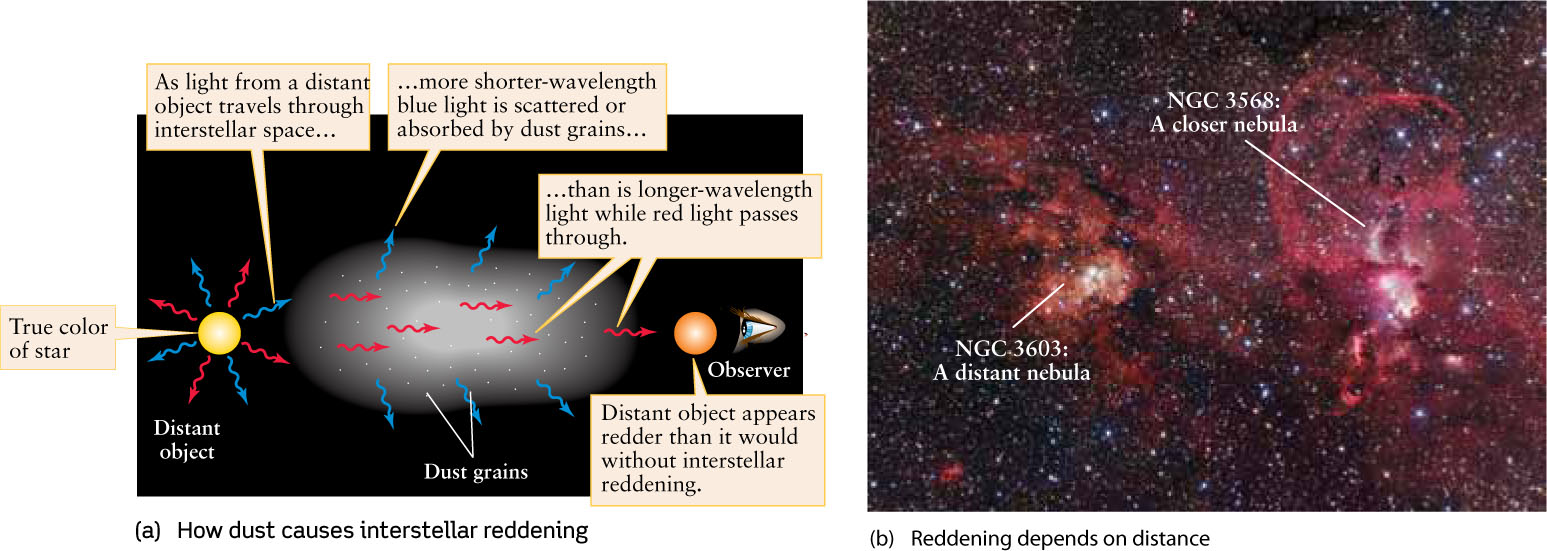
Interstellar Reddening (a) Dust grains in interstellar space scatter or absorb blue light more than red light. Thus, light from a distant object appears redder than it really is. (b) The emission nebulae NGC 3603 and NGC 3576 are different distances from Earth. Light from the more distant nebula must pass through more interstellar dust to reach us, so more interstellar reddening occurs and NGC 3603 is a deeper shade of red. The two nebulae are about 1° apart in the sky.
CAUTION!
It is important to understand the distinction between interstellar reddening and the Doppler effect. If an object is moving away from us, the Doppler effect shifts all of that object’s light toward longer wavelengths (a redshift). Interstellar reddening, by contrast, makes objects appear red not by shifting wavelengths but by filtering out shorter blue wavelengths. The effect is the same as if we looked at an object through red-colored glasses, which let red light pass but block out blue light. The one similarity between Doppler shifts and interstellar reddening is that neither has any discernible effect on what you see with the naked eye. Both of these effects cause only subtle color changes that your eye (which does a poor job of seeing colors in faint objects like stars) cannot detect. If you see a star with a red color, the reason is not interstellar reddening or the Doppler effect; it is because the star really is red due to its low surface temperature (see Figure 17-7a).
Interstellar Gas and Dust in Spiral Galaxies
Observations indicate that interstellar gas and dust are largely confined to the plane of the Milky Way—that faint, hazy band of stars you can see stretching across the sky on a dark, moonless night. Figure 18-7 shows glowing emission nebulae and dark lanes of dust along the Milky Way.
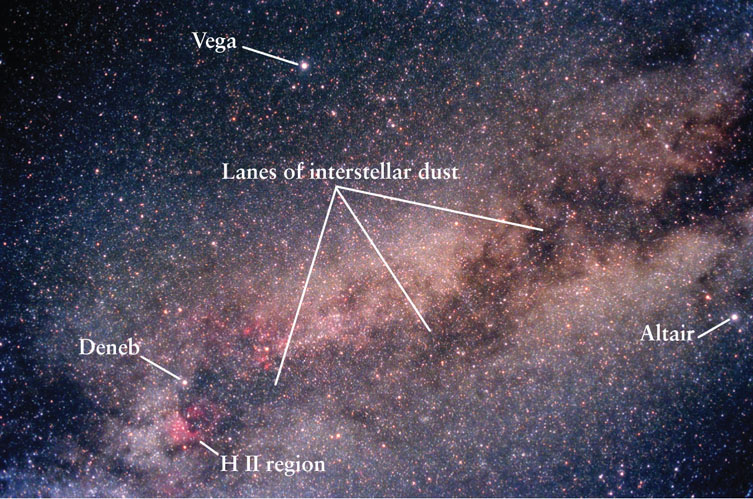
Gas and Dust in the Milky Way There are so many stars that they aren’t easy to see individually, resulting in the diffuse whitish band that gives the Milky Way its name. Red glowing gas clouds (emission nebulae or H II regions) can be seen in the foreground, and dark, dusty regions that block starlight are concentrated close to the midplane of the Milky Way Galaxy. This wide-angle photograph also shows the three bright stars that make up the “summer triangle” (see Figure 2-8).
511
As we will see in Chapter 23, the band of the Milky Way is actually our inside view of our Galaxy, which is a flat, pancake-shaped collection of several hundred billion stars about 50,000 pc (160,000 ly) in diameter. The Sun is located inside this pancake shape and is about 8000 pc (26,000 ly) from our Galaxy’s center. Astronomers know these dimensions because they can map our Galaxy from the locations of bright stars and nebulae and also by using radio telescopes. Observations indicate that bright stars, gas, and glowing nebulae are mostly located within a few hundred parsecs of the midplane of our Galaxy, form somewhat of a “pancake” shape, and are concentrated along arching spiral arms that wind outward from the Galaxy’s center. If we could view our Galaxy from a great distance, it would look somewhat like one of the galaxies shown in Figure 18-8.
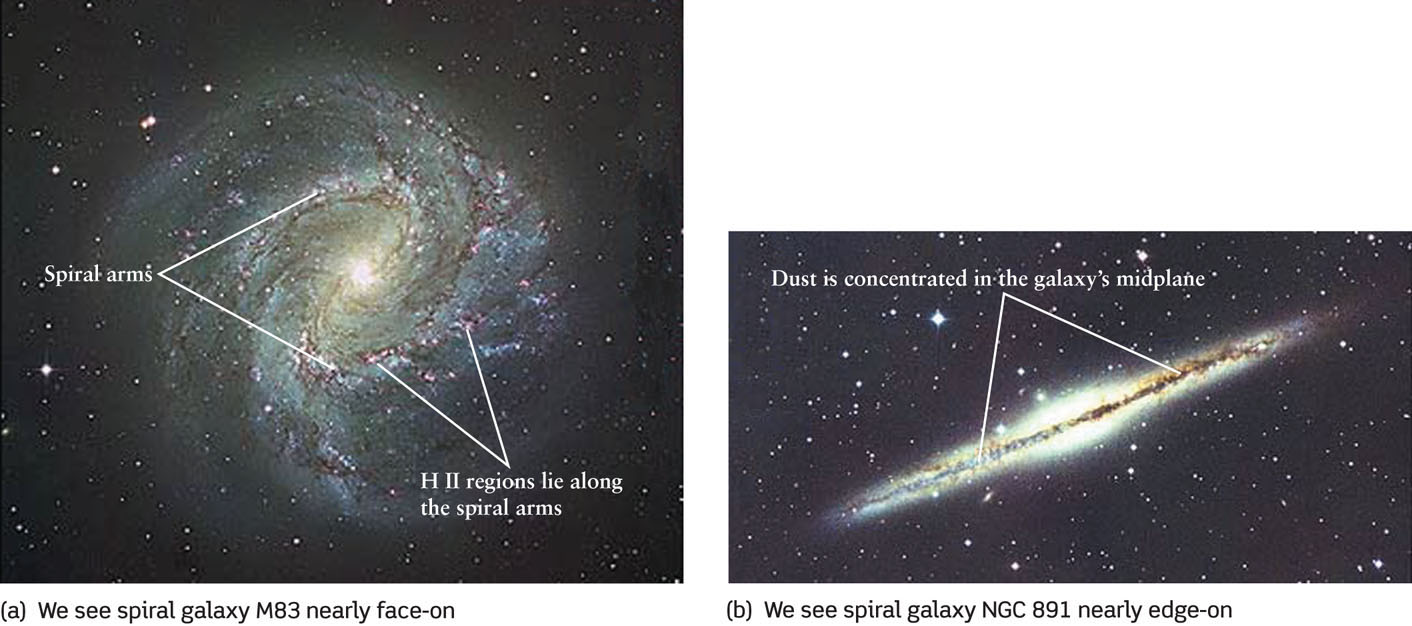
Spiral Galaxies Spiral galaxies, like our own Milky Way Galaxy, consist of stars, gas, and dust that are largely confined to a flattened, rotating disk. (a) This face-on view of M83 shows luminous stars and H II regions along the spiral arms. (b) This edge-on view of NGC 891 shows a dark band caused by dust in this galaxy’s interstellar medium. Although in different parts of the sky, both galaxies are about 7 million pc (23 million ly) from Earth and have angular diameters of about 13 arcminutes.
Interstellar gas and dust are the raw material from which stars are made. The disk of our Galaxy, where most of this matter is concentrated, is therefore the site of ongoing star formation. Our next goal is to examine the steps by which stars are formed.